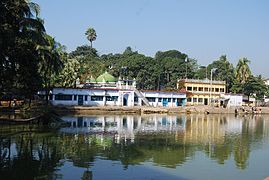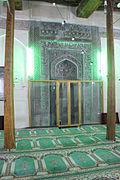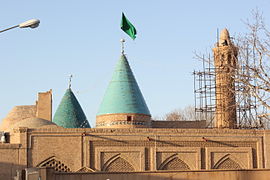Bayazid Bastami
This article is written like a personal reflection, personal essay, or argumentative essay that states a Wikipedia editor's personal feelings or presents an original argument about a topic. (July 2016) |
Bayazid Bastami | |
|---|---|
 | |
| Born | 804 |
| Died | 874[1] |
| Region | Western Asia |
| School | Sunni |
Main interests | mysticism, philosophy |
Notable ideas | Shukr |
| Part of a series on Islam Sufism |
|---|
 |
|
|
Abū Yazīd Ṭayfūr b. ʿĪsā b. Surūshān al-Bisṭāmī (al-Basṭāmī) (d. 261/874–5 or 234/848–9),[2] commonly known in the Iranian world as Bāyazīd Bisṭāmī, was a Persian[3] Sufi, from north-central Iran.[4][5] Known to future Sufis as Sultān-ul-Ārifīn ("King of the Gnostics"), Bastami, who was famous for "the boldness of his expression of the mystic’s complete absorption into the Godhead,"[6] was one of the pioneers of what later came to be known as the "drunken" or "ecstatic" (sukr) school of Islamic mysticism.
His grandfather Surūshān was born a Zoroastrian, an indication that Bastami had Persian origins despite the fact that his transmitted sayings are in Arabic. Very little is known about the life of Bastami, whose importance lies in his biographical tradition, since he left no written works. The early biographical reports portray him as a wanderer[7] but also as leading teaching circles.[8] They describe him as a mystic dismissive of excessive asceticism[9] but also as one scrupulous about ritual purity such as washing his tongue before chanting God’s names[10] and one appreciative of the work of the great jurists.[11] A measure of the influence of his image in posterity is the fact that he is named in the lineage (silsila) of one of the largest Sufi brotherhoods today, the Naqshbandi order.[12]

Background
The name Bastami means "from Bastam". Bayazid's grandfather was a Zoroastrian who converted to Islam.[13] His grandfather had three sons, Adam, Tayfur and 'Ali. All of them were ascetics. Bayazid was born to Tayfur. Not much is known of his childhood, but Bayazid spent most of his time in isolation in his house and the mosque. Although he remained in isolation, he did not isolate himself from the Sufi realm. He welcomed people into his house to discuss Islam. Bayazid also led a life of asceticism and renounced all worldly pleasures in order to be one with Allah The Exalted. Ultimately, this led Bayazid to a state of "self union" which, according to many Sufi orders, is the only state a person could be in order to attain unity with God.
Influence
Bastami's predecessor Dhul-Nun al-Misri (d. CE 859) was a murid "initiate" as well.[14] Al-Misri had formulated the doctrine of ma'rifa (gnosis), presenting a system which helped the murid and the sheikh (guide) to communicate. Bayazid Bastami took this a step further and emphasized the importance of religious ecstasy in Islam, referred to in his words as drunkenness (Shukr or wajd), a means of self-annihilation in the Divine Presence of the Creator. Before him, the sufi path was mainly based on piety and obedience and he played a major role in placing the concept of divine love at the core of Sufism.
When Bayazid died he was over seventy years old. Before he died, someone asked him his age. He said: "I am four years old. For seventy years I was veiled. I got rid of my veils only four years ago.”
Bayazid died in 874 CE and is buried either in Bistam. There is also a shrine in Kirikhan, Turkey with the name of Bayazid Bastami (an attribute not real).[citation needed]
Shrine in Chittagong, Bangladesh
A Sufi shrine in Chittagong, dating back to 850 AD, is dedicated to the Bayazid.[15] While there is no recorded evidence of his visit to the region, Chittagong was a major port on the southern silk route connecting India, China and the Middle East, and the first Muslims to travel to China may have used the Chittagong-Burma-Sichuan trade route. Chittagong was a religious city and also a center of Sufism and Muslim merchants in the subcontinent since the 9th century, and it is plausible that either Bayazid or his followers visited the port city around the middle of the 9th century.[1]
Gallery
-
Bayazid Bastami's shrine in Chittagong, Bangladesh
-
Interior of Bayazid's Mosque
-
Dome of Bayazid's Mosque
-
Carving of Bayazid's Mosque
See also
Notes
- ^ a b Karim, Abdul (2012). "Bayejid Bostami". In Islam, Sirajul; Jamal, Ahmed A. (eds.). Banglapedia: National Encyclopedia of Bangladesh (Second ed.). Asiatic Society of Bangladesh.
- ^ The Darvishes: Or Oriental Spiritualism By John Pair Brown, p. 141
- ^ Walbridge, John. "Suhrawardi and Illumination" in "The Cambridge Companion to Arabic Philosophy" edited by Peter Adamson, Richard C. Taylor, Cambridge University Press, 2005. pg 206.
- ^ Walbridge, John. "Suhrawardi and Illumination" in "The Cambridge Companion to Arabic Philosophy" edited by Peter Adamson, Richard C. Taylor, Cambridge University Press, 2005. pg 206.
- ^ Mojaddedi, Jawid, “al-Bisṭāmī, Abū Yazīd (Bāyazīd)”, in: Encyclopaedia of Islam, THREE, Edited by: Kate Fleet, Gudrun Krämer, Denis Matringe, John Nawas, Everett Rowson.
- ^ A. J. Arberry (tr.), Muslim Saints and Mystics: Episodes from the Tadhkirat al-Auliya’ (Memorial of the Saints) (Ames: Omphaloskepsis, 2000), p. 119
- ^ Abū Nuʿaym ʿAlī b. Sahl Iṣfahānī, Ḥilyat al-awliyāʾ, 10 vols., Cairo 1932–8, 10:33
- ^ Al-Iṣfahānī, 10:34
- ^ Al-Iṣfahānī, 10: 36–7
- ^ Al-Iṣfahānī, 10:35
- ^ Al-Iṣfahānī, 10: 36
- ^ Mojaddedi, “al-Bisṭāmī, Abū Yazīd (Bāyazīd)”, Encyclopaedia of Islam, THREE
- ^ al-Qushayri, Abu 'l-Qasim (2007). Alexander D. Knysh; Muhammad Eissa (ed.). Al-Qushayri's Epistle on Sufism : Al-Risala al-qushayriyya fi 'ilm al-tasawwuf. Alexander D. Knysh (trans.) (1st ed.). Reading, UK: Garnet Pub. p. 32. ISBN 978-1859641866.
{{cite book}}: CS1 maint: multiple names: editors list (link) - ^ al-Qifti, Tarikh al-Hukama' [Leipzig, 1903], 185; al-Shibi, op. cit., 360
- ^ "Bangladesh: A pivot of the south-eastern Silk Road?". New Age. Dhaka. Archived from the original on 26 December 2013.
References
- Arthur John Arberry, Bistamiana, BSOAS 25/1 (1962) 28–37
- ʿAbd al-Raḥmān al-Badawī, Shaṭaḥāt al-Ṣūfiyya, Cairo 1949
- Carl W. Ernst, Words of ecstasy in Sufism, Albany 1985
- Carl W. Ernst, The man without attributes. Ibn ʿArabī’s interpretation of al-Bisṭāmī, Journal of the Muhyiddin Ibn ʿArabi Society, 13 (1993), 1–18
- ʿAbd al-Rafīʿ Ḥaqīqat, Sulṭān al-ʿĀrifīn Bāyazīd Basṭāmī, Tehran 1361sh/1982
- Max Horten, Indische Strömungen in der islamischen Mystik, 2 vols., Heidelberg 1927–8
- ʿAlī al-Hujwīrī, Kashf al-maḥjūb, ed. V. A. Zhukovskiĭ, Leningrad 1926 repr. Tehran 1957
- Abū Nuʿaym ʿAlī b. Sahl Iṣfahānī, Ḥilyat al-awliyāʾ, 10 vols., Cairo 1932–8
- ʿAbd al-Raḥmān Jāmī, Nafaḥāt al-uns, ed. Maḥmūd ʿĀbidī, Tehran 1370sh/1991
- Mahmud Khatami, Zaehner-Arberry controversy on Abu Yazid the Sufi. A historical review, Transcendent Philosophy 7 (2006), 203–26
- Abdelwahab Meddeb (trans.), Les dits de Bistami, Paris 1989
- Jawid Ahmad Mojaddedi, The biographical tradition in Sufism. The Ṭabaqāt genre from al-Sulamī to Jāmī, Richmond, Surrey 2001
- Jawid Ahmad Mojaddedi, Getting drunk with Abū Yazīd or staying sober with Junayd. The creation of a popular typology of Sufism, BSOAS 66/1 (2003), 1–13
- Reynold A. Nicholson, An early Arabic version of the Miʿrāj of Abū Yazīd al-Bisṭāmī, Islamica 2 (1926), 402–15
- Javād Nūrbakhsh, Bāyazīd, Tehran 1373sh/1994
- Hellmut Ritter, Die Aussprüche des Bāyezīd Bisṭāmī, in Fritz Meier (ed.), Westöstliche Abhandlungen (Wiesbaden 1954), 231–43
- Jalāl al-Dīn Rūmī, Fīhi mā fīhi, ed. Badīʿ al-Zamān Furūzānfar, Tehran 1957
- Jalāl al-Dīn Rūmī, Mathnawī, ed. Reynold A. Nicholson, 8 vols., London 1925–40
- Rūzbihān Baqlī, Sharḥ-i shaṭḥiyyāt, ed. Henri Corbin, Tehran 1966
- al-Sarrāj, Kitāb al-lumaʿ fī l-taṣawwuf, ed. Reynold Alleyne Nicholson, Leiden and London 1914
- August Tholuck, Ssufismus sive Theosophia Persarum pantheistica, Berlin 1821
- Robert C. Zaehner, Abū Yazīd of Bisṭām. A turning point in Islamic mysticism, Indo-Iranian Journal 1 (1957), 286–301
- Robert C. Zaehner, Hindu and Muslim mysticism, London 1960.




